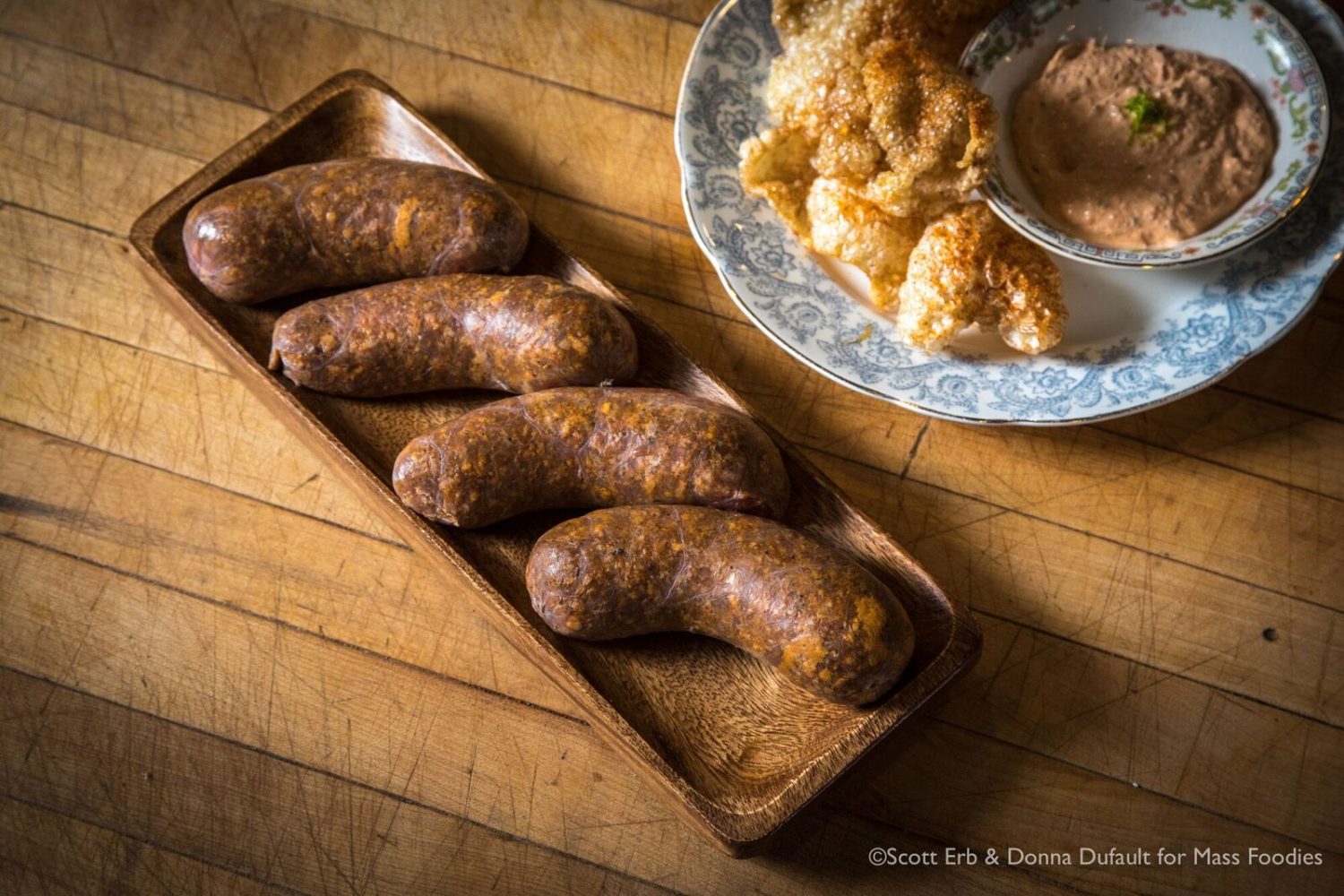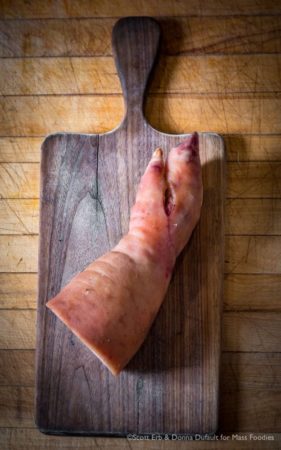
tHugo Desnoyer is the butcher for some of Paris’s most acclaimed restaurants, bistros, and wine bars. He also runs a gleaming marble-tiled retail shop. Rarely having access to a kitchen when I visited Paris, I still found myself drawn to his shop in the 15th arrondissement near the Bois de Boulogne. On various visits over the last two decades, I have stared longingly into the display case, repeating the word viandes viandes viandes as if repetition could conjure me a stove and cast iron skillet for an entrecôte. Puis-je vous aider? asks the counterman. Non, merci, I say, silently cursing my flameless existence. Merde.
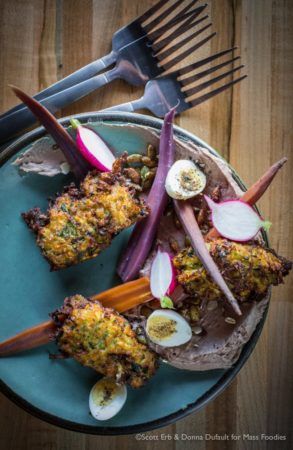 I must have not been alone in my droolish behavior. A few years ago, Desnoyer placed a single communal table – a large butcher block surrounded by no more than ten chairs – in the window of his shop. To dine while staring at all the meaty goodness on offer is to truly know what John Cleese meant when he said, if we aren’t supposed to eat animals then why are they made out of meat?
I must have not been alone in my droolish behavior. A few years ago, Desnoyer placed a single communal table – a large butcher block surrounded by no more than ten chairs – in the window of his shop. To dine while staring at all the meaty goodness on offer is to truly know what John Cleese meant when he said, if we aren’t supposed to eat animals then why are they made out of meat?
Thankfully, I didn’t have to wait that long in Worcester for the same experience and no one has to fight for a table (yet). Worcester may have been the Paris of the eighties as a t-shirt said, but our restaurant scene is decidedly now. And two of the city’s newest arrivals, Rachel Coit and Matt Mahoney, conjure the spirit of Desnoyer with their butcher-shop-cum-restaurant in the Canal District – even if it bears a distinctly German name: Kummerspeck.
Kummerspeck translates to “grief bacon” (basically German for “comfort food”) but the restaurant is not German or French (even if it was, the French translation for comfort food is aliment-réconfort which sounds profoundly unappetizing). What it really translates to is a unique non-regional comfort food experience in Worcester. Comfort food that makes you long for home and kicks your grandmother’s food’s ass.
And that’s just what chef/owners Matt (director of all things awesome) and Rachel (please help her find an equally good name) want.
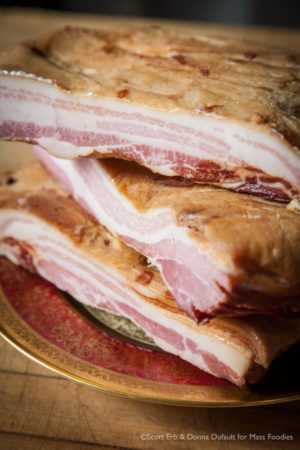 The couple, married since 2011, met in culinary school where both of them were late starts among a sea of teenagers. Rachel says she said “Hey!” to Matt on the first day but Matt just grunted at her. (He doesn’t remember that but admits it’s plausible.) It took an intervention by one of their favorite instructors to officially set them up. They married shortly after finishing school. Both then honed their craft working for Barbara Lynch in Boston: he at The Butcher Shop, she at Sportello. When they decided to strike out on their own, they thought about Detroit, Portsmouth, and Portland (ME), but eventually settled on Worcester. “We thought Worcester could use something like this,” Matt says. “Worcester is really trying. It’s finally busting its ass for really big things.”
The couple, married since 2011, met in culinary school where both of them were late starts among a sea of teenagers. Rachel says she said “Hey!” to Matt on the first day but Matt just grunted at her. (He doesn’t remember that but admits it’s plausible.) It took an intervention by one of their favorite instructors to officially set them up. They married shortly after finishing school. Both then honed their craft working for Barbara Lynch in Boston: he at The Butcher Shop, she at Sportello. When they decided to strike out on their own, they thought about Detroit, Portsmouth, and Portland (ME), but eventually settled on Worcester. “We thought Worcester could use something like this,” Matt says. “Worcester is really trying. It’s finally busting its ass for really big things.”
Matt says “finally,” because both he and Rachel know the city well. He grew up in Spencer, she in Harvard. Worcester always had its meat eaters but now it had a culinary movement too: “Worcester is a relatively adventurous city,” Matt adds. “People aren’t freaked out by certain things like liver. Liver pate is one of the best sellers on our menu.” Rachel laughs in agreement, “They don’t believe that there are bacon harvesters that come by every week leaving happy living pigs behind.”
True. But this is also not a city conditioned to spend a lot of money on that meat, and Matt and Rachel, along with their head butcher/executive sous chef Erin Hockey, have filled their display cases with exquisite prepared foods, hot sauces, dips (including a hot sausage one for game day that I would like to be buried in), marinades, duck fat, veal fat, pork lard, foie gras terrine, duck confit, a seemingly endless array of homemade fresh and smoked sausages, and an evolving selection of fresh beef, pork, duck, lamb, and goat. The day I was there, American wagyu and three different kinds of strip steaks were available and there was discussion of barnsley chops (a cut taken from across the loin to make a double sided chop). And don’t think it stops at meat. Rachel likes to break down a whole fish and has been experimenting with a green tea smoked salmon cured with nori.
Mon dieu! Oh mein Gott! Oh. My. God!
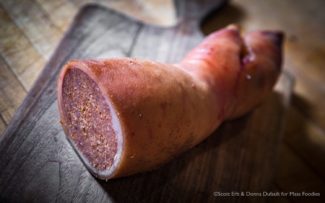 But also trop cher for people used to D’Errico’s and Fairway, where ground beef is often less than half the price of Kummerspeck’s. For those who wonder why, the Kummerspeck team is happy to answer – and more importantly welcome the question. Too often, I find people working the high end of any food business look down on those who just don’t understand why. Not Matt and Rachel. They are not only happy to explain but also educate and accommodate.
But also trop cher for people used to D’Errico’s and Fairway, where ground beef is often less than half the price of Kummerspeck’s. For those who wonder why, the Kummerspeck team is happy to answer – and more importantly welcome the question. Too often, I find people working the high end of any food business look down on those who just don’t understand why. Not Matt and Rachel. They are not only happy to explain but also educate and accommodate.
“We can explain the prices to them,” says Matt. “First of all we have to pay Erin who makes all the difference in the world. And the meat? It’s better than what you get in most markets. I am buying everything from very high-end to slightly better than what the commodity is. I love those places you mentioned. They are iconic. But you are not going to get someone who is going to turn around and talk about what they’re cutting for you.
“We cut you what you want. I will bone what you want. I will wrap it in fatback and truss it with rosemary. But we are not just butchers. We are chefs. We will teach you how to cook what you buy. Who wants to spend that money to ruin something expensive like lamb? Say you want to try duck, which is not that expensive. Duck is not difficult but you have to know the tricks to it. It’s not like throwing a steak in the pan. Sometimes the most important thing is just walking people through the purchase so they know that duck doesn’t suck.”
That said, Matt and Rachel are happy to offer something closer to the price points people expect as a step up to the premium cuts. For a recent Patriots game, they bought a bunch of choice strips – Midwestern grain-fed – for $12 a pound. That’s close to what you might pay at other markets but customers will still get the butcher/chef treatment at Kummerspeck. Matt and Rachel won’t alienate anyone because they went for the cheapest option. They want them to learn from it, Matt says: “If you don’t, you walk away and never eat better. You never get a chance to get why the $27 per pound steak is worthwhile once in a while. You might cook a great steak, but I can probably tell you how to cook a great steak and just tweak it to just set it off and really make you appreciate the money you spent.”
This sensitivity translates to the Kummerspeck menu as well. While both Matt and Rachel have worked in fine dining, their dishes at Kummerspeck are not tweezer food with a shiso leaf placed just-so. Still, Rachel makes sure they are “cooking with color” and every dish is not only beautifully plated but “fundamentally thought through how people are going to eat the dish” for the full flavor experience. For Matt’s part, he makes sure there is always value and enough food on the plate even at the higher end of the menu: “Quality and service are crucial but there has to be enough on the plate. You may pay $14 for the Zampone [the front trotter of a pig stuffed with a mixture of lentils, belly, and fat back] but the portion is huge and easily shareable.”
Initially, both Matt and Rachel admit their menu played it kind of safe as they got used to executing. “The regular menu is like a photo album of our culinary lives,” says Rachel. “We are making things we missed that we wanted or love to eat like cauliflower hash. My shrimp and grits is the perfect example. This is a recipe that I have brought with me everywhere. I make it a little spicy with some smoked andouille. It’s always a crowd pleaser. [Matt calls it the best dish in the city.] It is one of those dishes that once people try, they feel more comfortable ordering more expensive things and trust us.”
And customers are doing just that. When Kummerspeck got in a couple of large lambs from Lilac Hedge, they took the entire neck from each, rubbed them down, and roasted them all night. They then offered them family-style for four with a cracked wheat salad, cucumber, tomatoes, and chard. They sold out. So did the four pigs’ heads that they roasted slow, presented to the tables, and then served the crispy skins and meat Asian style with a pho noodle salad and cilantro.
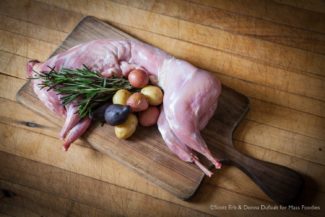 That’s a wow dish, but it is not like Matt and Rachel don’t practice what they preach from the butcher counter with the simplest of dishes: “People say to us all the time, ‘What did you do to the steak?’ But it’s really what you don’t do to it. It’s a really good steak with butter, salt, black pepper, basted in the fat of that animal.”
That’s a wow dish, but it is not like Matt and Rachel don’t practice what they preach from the butcher counter with the simplest of dishes: “People say to us all the time, ‘What did you do to the steak?’ But it’s really what you don’t do to it. It’s a really good steak with butter, salt, black pepper, basted in the fat of that animal.”
If that doesn’t comfort you, carnivores, what will? Maybe what’s next. Kummerspeck has big plans from a tasting menu (chef’s choice to “let it rip!”) to a full brunch roll out to carving stations to Erin leading butchering classes on the original 1969 butcher block from Tom’s that once occupied the space. (For a preview, check out the video.)
In the end, Matt and Rachel want Kummerspeck to be an interactive place. They want you to pass dishes around. They want you to pick up your plate and lick it (which is good news for my mom). “When I serve a big porterhouse, I take it off the bone and slice it. But I leave enough on the bone so when I stick it out of the mashed potatoes and send it to your table you have no choice but to pick it up. I’m leaving several bites on there. That’s what we want the atmosphere to be here, says Matt” Adds Rachel, “If I see you do that or lick your plate, we did our job. We embrace the primal.”
But don’t be surprised when you do pick up that plate if you spy Matt or Rachel watching. “I love watching people eat,” Rachel laughs. “It’s super creepy but I love doing it.” Matt agrees: “I watch people take the first bite. It keeps you going.” In a word: it’s comforting.
Jim Eber visits Worcester’s Kummerspeck, where Matt Mahoney and Rachel Coit want to make restaurants more interactive by incorporating a delicatessen within the restaurant and bar’s walls. – https://massfoodandwine.com/chefs/matt-rachel-want-worcesters-kummerspeck-to-be-an-interactive-restaurant/
Posted by Mass Foodies on Thursday, October 12, 2017

